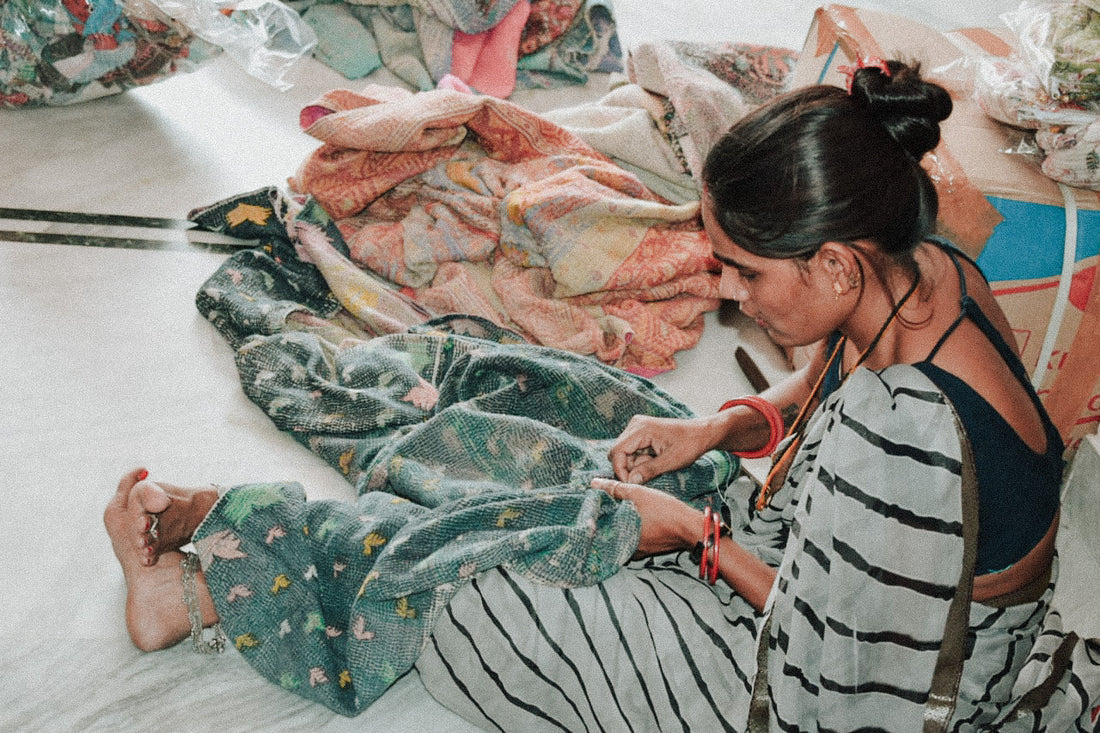
Rediscovering kantha embroidery: A journey through time and tradition
Share
In the heartland of eastern India, a centuries-old tradition weaves a tapestry of stories, hopes and artistic expression - welcome to the enchanting world of TAANKA celebrating kantha embroidery. As we dive into the rich history and vibrant revival of this unique craft, we uncover the threads that connect generations and cultures.
A thousand years unfolding: The origins of Kantha
For more than a thousand years, kantha embroidery has been an integral part of the cultural fabric of eastern India. Born out of necessity, babies were wrapped in soft kantha quilts made from frayed saris and dhotis (a loose piece of clothing wrapped around the lower half of the body, worn by some men from South Asia). Special kantha rugs furbished homes, creating an atmosphere of tradition and warmth. Dating back to the pre-Vedic era (before 1500 B.C.), kantha was not just a functional form of embroidery; it was a celebration of life's events and a canvas on which ordinary women could tell their stories.
The art of repurposing: Kantha's evolution
Originating in East Bengal (now Bangladesh) and West Bengal, kantha was a practice in which thrifty women repurposed discarded clothing with simple running stitches. The resulting quilts and functional items, such as bed covers, had a slightly wrinkled appearance. This was due to the multiple lines of running stitches. Over time, the craft evolved, giving rise to nakshi kantha with more intricately embroidered patterns.



Today, kantha has found its place not only in West Bengal and Bangladesh, but also in parts of Odisha and Bihar in India. It resonates in other cultures around the world, such as Japan's Boro and Central Asia's Suzani embroidery. Kantha shares its roots with these diverse embroidery traditions and is known as "sujani", the word for stitch or needle.
Symbolism and tradition: Stories woven in stitches
What sets kantha apart from other textiles is its ability to tell stories through its patterns. These stitches often symbolize affection for loved ones and were believed to offer protection from the evil force. First mentioned in a 500-year-old book, Chaitanya Charitamrita, the name 'kantha' may derive from 'kontha', the Sanskrit word for rags. According to the story, the mother of the 15th century saint, Chaitanya Mahaprabhu, sends a home-made kantha to her son via a travelling pilgrim.

Beyond its practical roots in up-cycling, the kantha has also become a canvas for women to express their artistic talents. In Hindu households, it was often a depiction of religious iconography and mythology, while in Muslim households, it incorporated Islamic and Persian influences with geometric and floral motifs.
From domestic craftsmanship to timeless artistry
In its origins, kantha was a domestic craft practiced by women in charge of household management, cattle breeding, and childcare. Sometimes the same piece of kantha was passed from mother to daughter, simply by pure love. Over the centuries, kantha has diversified in its uses, serving as everything from a make-up case (arshilota) to a clothes bag (bostani) to a rug (galicha). Red, black, and blue dominated early kantha work and have now evolved into a kaleidoscope of colors. While running stitch is still the dominant technique, blanket stitch and chain stitch are adding delicacy to the creative process.
Influences and fusion: Kantha's global journey
Though deeply rooted in Indian traditions, kantha has seamlessly absorbed the influences of colonial rule and Portuguese traders. Silk threads and motifs such as sailing ships and coats of arms found their way into kantha under Portuguese patronage. A fascinating 19th-century kantha at New Delhi's National Crafts Museum mixes Hindu mythology with European-inspired elements, illustrating the craft's ability to adapt and evolve.

A Bengali embroidered kantha quilt from the 19th Century portrays typical animal and floral motifs in a variety of stitches (Credit: Alamy)
Family aspirations and motifs of hope
Kantha was more than a craft; it represented the hopes and aspirations of a family. Made by mothers and grandmothers who intricately woven hopes, wishes and family history into the fabric, wedding dowries were also decorated with kantha. The lightweight quilts weren't just practical; they also served as prayer mats and signs of warmth during monsoons and winters.

Each kantha is a unique creation with no formal rules. While some symbols and motifs are universal, the design depends on the individual composition, technique, and color scheme of the creator. It's a craft that belongs to communities, never commissioned by the elite. Even during the 18th and 19th centuries under British colonial rule, Kantha continued to be practiced by rural women, preserving its authenticity.

Celebrating the revival of kantha embroidery, TAANKA is wrapped in history, surrounded by threads that transcend time. Join our journey, immerse yourself in the stories woven through the stitches - TAANKA, where tradition meets revival.
